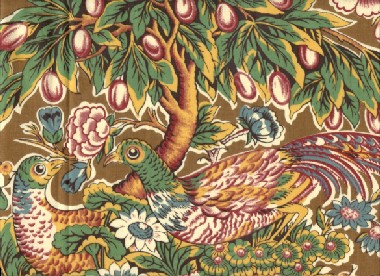
Even someone new to antique quilt
appreciation is likely to recognize the featured chintz in Harriet
Hargrave's new
line "Birds and Basics" by P&B Textiles. It is a genre
of chintz that had immense popularity in its day, 1815-35 and can been seen
on many of the surviving quilts in museums and private collections.
On the left is the original, on the
right is the reproduction. (reduced by 50%)
Original from the
collection of Julia D. Zgliniec
Can you tell
the difference? Great job I think. Harriet dates her line to the 1840s and used
her own quilts for inspiration. The other two colorways are quite nice
too!
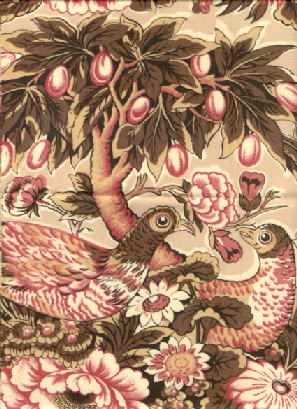 This chintz print is
historically from a genre of Game Birds and Tree prints that were printed on
tea, tan or medium brown backgrounds from around 1815 to 1835, but reproduction
of them have been made up to the present day in the furnishing fabrics
industry. A large print like this would not have been used for clothing,
but for drapery and upholstery and bedding. This chintz print is
historically from a genre of Game Birds and Tree prints that were printed on
tea, tan or medium brown backgrounds from around 1815 to 1835, but reproduction
of them have been made up to the present day in the furnishing fabrics
industry. A large print like this would not have been used for clothing,
but for drapery and upholstery and bedding.
Florence
Montgomery describes this particular print as the pheasants and plum tree on a
tan ground made about 1815 using the block print method. It was made with a
roller printer around 1835 and beyond. (Printed Textiles, pg. 160)
Mary
Schoeser describes a close cousin of this pattern that features one pheasant
under a palm tree with very similar flowers surrounding it: "isolated
islands were a distinctive feature of block-printed cottons in the years around
1815...This type of design must have been extremely popular,
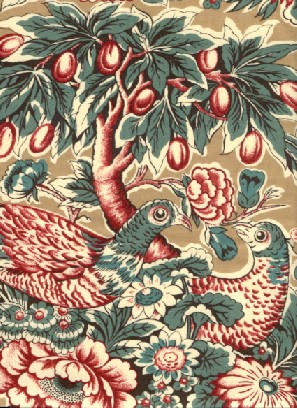 since many examples
survive, particularly in the U.S. (suggesting that such designs were among those
'dumped' on the American market in the attempt to stifle the development of
their textile industry after the War of 1812 ended, in Dec. 1814). (English and
American Textiles, with Celia Rufey, pg. 57) The V&A Museum
credits this 'madder-style' print in their collection to Bannister Hall,1815.
(Victoria & Albert Museum, English Printed Textiles, block No. 46) since many examples
survive, particularly in the U.S. (suggesting that such designs were among those
'dumped' on the American market in the attempt to stifle the development of
their textile industry after the War of 1812 ended, in Dec. 1814). (English and
American Textiles, with Celia Rufey, pg. 57) The V&A Museum
credits this 'madder-style' print in their collection to Bannister Hall,1815.
(Victoria & Albert Museum, English Printed Textiles, block No. 46)
Patricia
Smith, in her Calico and Chintz book, illustrates several different bird and
tree prints popular between 1814 -16 and1825-1835. Other game birds used
frequently were peacocks and partridges. Most of the prints in this genre had
tea grounds and vivid colors of greens, blues, reds and yellows (p. 94-95)
Deemed
worthy of mention in the writings of Confucius, the juicy plum has been grown in
China since ancient times. The birds in this print sit under a plum tree with
oval shaped reddish fruit. Lao-Tse, the famous Chinese philosopher, is
thought to have been born under a plum tree a lucky occurrence since the Chinese
believe plums symbolize good fortune. There are numerous tributes to the plum in
Chinese culture. Confucius likens their beauty to a loved one. (About.com,
Visions of Plums)
The eight smaller prints that accompany this
feature fabric are in three main colorways, beige/browns, dark and light
pinks, and blue/greens or teal, to correspond with the bird and tree colorways.
It seems that most of them would look good with any colorway of the large
print. I will picture the more densely colored ones so that you can see
the detail, but there are light beige tone colorways. These are adjusted
to make the motif it's actual size.
This one is quite unique and
is in teal, a color we need more of for reproducing mid-19th C. quilts. It is a
true teal, tone on tone, even if it doesn't appear that way on your monitor.
One has an India flair. This
print style was swiftly taken up in the south of France;

Others
remind me of textured woven cloth:
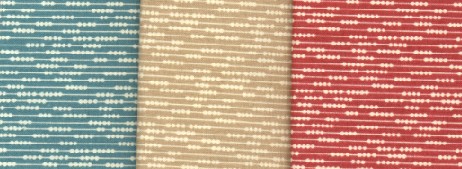
Picotage,
tiny dots forming a design, were popular since woodblock printers put tiny nails
into their blocks, but the roller printing machine made it a much more common
method of printing cloth. Designers used nature herself during this early
time. Later on they copied from other designer's work and then added more to it.
Somewhere along the line nature as the model was pushed aside, most noticeably
in the 1850s when speaking about chintz prints.
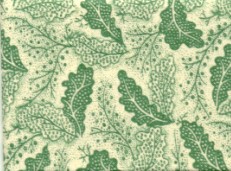
The
print above also comes in beige on ecru, dark pink on ecru, and teal on ecru.
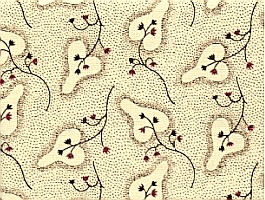
This is a dark brown print with some
dark red flowers too on beige. Another print has two shades of teal, and the
other is tan on ecru with some dark red flowers.
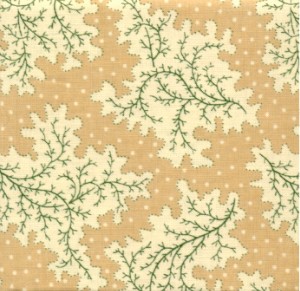
This medium-large scale, but delicate, print also comes
a pretty pinkish-beige
ground with medium brown leave veins and a tan ground
with dark red veins,
oth with ecru as the third color like the one above.
Most
of the smaller prints are new designs in the reproduction marketplace. There are
two which are similar to other reproductions, the small printed plaid and the
flower-head print. It's not that unusual these days for two or three different
textile companies to reproduce the same print, sometimes concurrently,
quite by chance. I find that
amazing, given all the different prints there are. I say, you can't get too much
of a good thing, as the poor designs are not usually the ones everyone wants to
reproduce. It reminds me of the 100th Monkey Theory too!
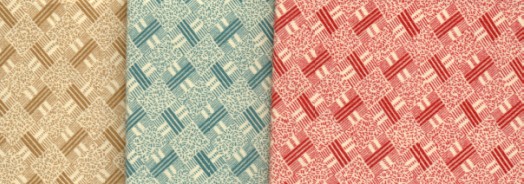
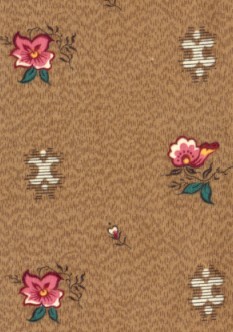 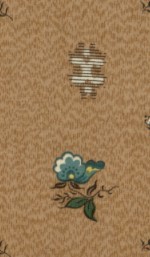
There is a pink
and brown on beige combination as well.
This fleur print with large areas of a textured-looking ground between the
fleurs reminds me of Civil War prints, so I recommend using it for quilts of
that time frame too.
Reproducing a quilt from the time period that the bird chintz was popular would
include such styles as the strippy quilt, or as the wide border on a block
quilt, of Ohio Stars, or Chips & Stones, or any block you like. It
could also go around a Star of Bethlehem as the border and also be a row of
diamonds within it. Adding a large scale polychrome print to a small
diamond in this large star will give a touch of several colors in each piece,
and add interest to that row. Another way to show off this glorious fabric is to
make a quilt that has large square alternate block between blocks of appliqué or
patchwork.
In the early 1800s it wasn't unusual
for a woman to cut a folded square of her precious chintz fabric into a large
pattern that in turn is appliquéd to a light colored ground. The large scale of
the chintz print, cut into a large appliqué design makes a very intriguing
quilt. Look through books of 19th century quilts for some examples. The
Shelburne Museums has two, they refer to as the Oak Leaf and Orange Slice
pattern. See "The Art of the Needle" on page
68 for one with sashing and "Enduring Grace" page 54 for one without
sashing. To make this one, use various large scale chintz fabrics
with the same large papercut appliqué pattern, such as the Oak Leaf and Reel, and you will have a stunning
early quilt replication. The quilt Harriet features in her pattern for
P&B is a sawtooth quilt using the other pieces of the collection for the
inner blocks and the chintz for the border.
Thank you to P&B Textiles for providing the fabric. All the information
above is my interpretation alone. Check with your local quilt shop to purchase
these fabrics.
|